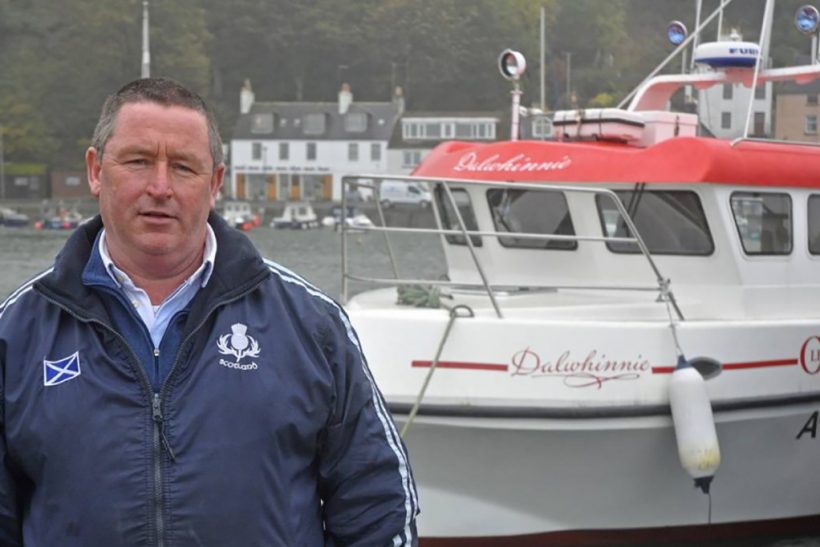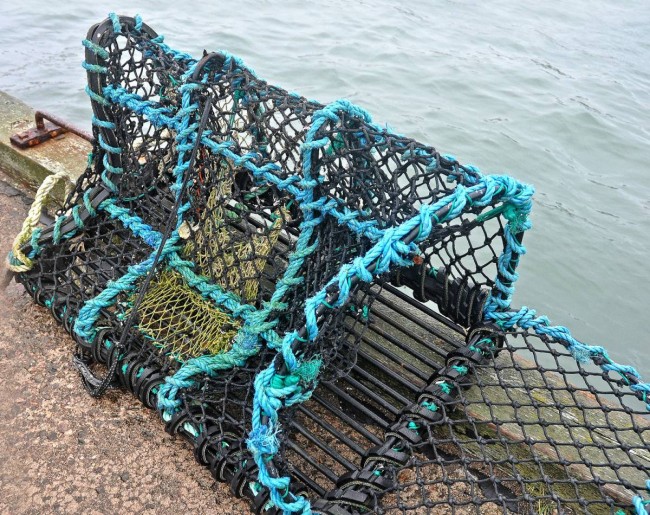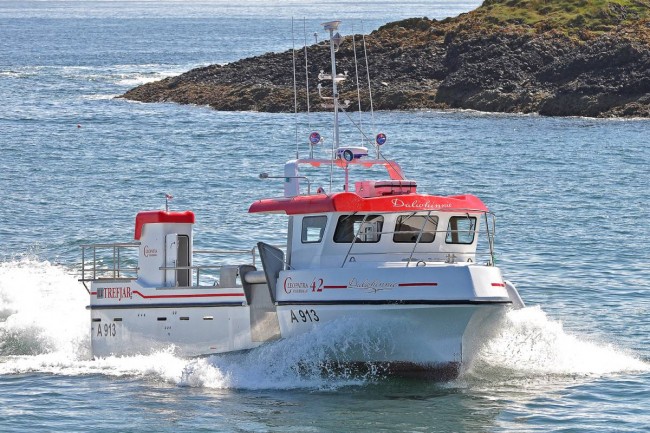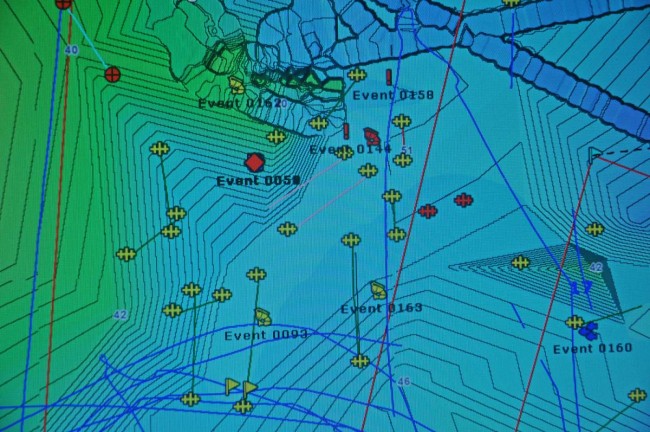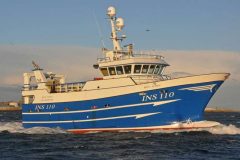Doing nothing is no longer an option, gear conflict issues need to be addressed with the upmost urgency.
After enduring 15 years of substantial static gear losses, Ian Mathieson, skipper/owner of the Stonehaven-based creel boat Dalwhinnie A 913, a Cleopatra Fisherman 42 built in 2011, has held meetings with Marine Scotland officials to highlight the severity of the problem and put forward proposals to resolve the longstanding and recurring issue, reports David Linkie.
Ian Mathieson has also brought his concerns and suggestions to the attention of Scottish Fisheries Minister Richard Lochhead, through his membership of the Scottish Creel Fishermen’s Federation and the recently formed Aberdeen Inshore Fishing Association, which has 10 member vessels fishing from Aberdeen, Stonehaven and Gourdon.
Ian Mathieson said: “In the past 15 years, I have continually tried to work with skippers of mobile gear vessels in order to avoid creels being towed away, by fishing in clearly defined boxes, the readings of which are constantly updated and readily available. While initially the readings were physically passed over to other skippers, today they are available electronically on the website of the SWFPA, of which I am a member. Non-member static gear boats also have direct access to this facility, which through skippers’ input, is constantly updated.
“Before continuing, I want to make it crystal clear that, like other creel boat skippers along the east and west coasts of Scotland, I have absolutely no problem with mobile gear boats fishing in close proximity to us, and fully recognise that they have their own set of problems to contend with. It is also important to point that that the vast majority of mobile gear skippers co-operate fully, and therefore are good to work with. However, as in all walks of life, a minority are not, and inevitably this results in substantial gear losses.
“Transfer of effort because of changing regulations in different fisheries has long been recognised as a major difficulty, although all too frequently it is an understated issue in fishing. Large beam scallopers, displaced from Area VII due to a shortage of days, regularly fish off the east coast of Scotland by necessity rather than choice. A similar situation occurred recently, when a combination of inadequate whitefish quotas and/or a shortage of fishing days, resulted in an influx of 20m+ squid trawlers fishing a few miles of Stonehaven.
“While fully sympathising with these lads for the difficult position they found themselves in due to rules and regulations applying to their fisheries, does this give them the leeway to sometimes blatantly tow through clearly marked static gear?
“Might is not always right. However, when management problems arise in one sector of the fleet, all too frequently they cascade down towards the smaller boats, with significant consequences.
“When the bigger nomadic scallopers started to fish off Stonehaven, I attempted to limit potential losses by working in clearly defined boxes on the top of peaky ground, which the scallopers couldn’t tow over. While this certainty wasn’t foolproof, it generally worked, and continues to help, thanks to those skippers who take the time to communicate in relation to static gear readings. The respect some mobile skippers show to their static gear counterparts clearly illustrates that, given the will, it is possible for everyone to fish in close proximity to each other, without any problems.
“One example of fishermen working together, and making the effort to help, was shown last month when a skipper phoned me to say that he recovered a lump of creels that went missing after being towed away out of a box. These creels were subsequently put ashore, enabling me to collect them and so avoid incurring a loss of around £1,000.
“When the squid trawlers started fishing in this area in August, each skipper was given the reading for a box seven miles long and 2.1 miles wide, five miles off the shore, that has given us a sustainable mixed crab and lobster fishery for the past four years.
“Initially, the squid boats found a steady fishing towing just inside the inner edge of this box. When catches started to tail off, they moved to the outer edge, where apparently catches were not so consistent. This led to boats starting to clip the corners of the inner box and, unsurprisingly, some creels were towed away. This situation quickly escalated, resulting in losses quickly moving north of £5,000.
“Apart from the financial cost of the creels, and the associated drop in catches, the most painful thing was the attitude of a minority of skippers, who complained that by fishing in our usual area, I was preventing them from earning good money. By constantly towing along ground on which healthy stocks of brown crab and lobster had been built up in recent years, through well-managed fishing, the benefits of sustainable fishing were effectively wiped out in a couple of weeks and will now take a long time to come back again.
“The final straw was observing a boat blatantly towing through clearly marked gear in the middle of the box on top of the ground, while yet again talking to Marine Scotland officials and advising them of the rapidly escalating carnage taking place.
“Gear conflict is by no means a new phenomenon, but it is one we have to put up with because Marine Scotland and the Scottish government are not dealing with it.
“This situation is intolerable, and cannot be allowed to continue.
“As Marine Scotland has no judicial powers, there was no other option left but to pass the information on to an authority that does. Although AIS tracks recorded on Dalwhinnie’s plotters identify boats towing through the middle of our leaders, where gear was subsequently found to be missing, proving this is a whole new ball game for the police, who are now investigating incidents of lost gear.
“I am fully aware of the fact that by speaking out about the problem, I will be extremely unpopular with some in our industry, but enough is enough; these blatant problems cannot be allowed to go on.
“Every static gear skipper accepts the fact that from time to time, a couple of creels will be lost off the end of a leader. But regularly losing 10/20/30 creels costing around £100 each, missing after a boat towed through an area where the location of static gear was advised to be located and clearly marked, is a totally different situation and mind-set.
“While losing gear is bad enough, large concentrations of creels and back ropes lying on the seabed for years to come does not exactly promote sustainable fishing, nor will it generate an image of a well-managed fishing industry in the eyes of the general public.”
Four proposals to reduce gear conflict
In his verbal and written communications with Scottish Fisheries Minister Richard Lochhead, and Jim Watson, Marine Scotland Head of Inshore Fisheries and Coastal Communities, skipper Ian Mathieson outlined four steps that could be taken to reduce ‘the long-standing problem of rogue vessels towing away and dumping static gear, that will continue until Marine Scotland take action to stop it’.
● Increase VMS pings from one every two hours to one every 10 minutes
Increasing the frequency of VMS pings to every 10 minutes would facilitate greater accuracy in plotting vessel movements, and help identify vessels responsible if static gear is towed away. The increase in VMS pings to be done on a trial period only, in coastal conflict areas rather than applying to the entire fleet.
● Encourage the MCA to enforce the legal requirement of >15m vessels to use AIS at all times
Compliance with this legal requirement would assist in tracking boats responsible for towing away static gear. Marine Scotland could assist the MCA with the enforcement through VMS. By sharing this information, Marine Scotland could inform the MCA when vessels are not displaying AIS. Marine Scotland could then decide what action to take with persistent offenders.
● Introduce a permit system that would ensure timely information sharing between fishermen
Implementing a permit system (at no cost nor dependent on previous track record) would guarantee the opportunity for Marine Scotland Fishery Officers to ensure that mobile gear skippers received the detailed positions of all static gear in an area, together with contact details for static gear skippers, when permits were issued in person at Fishery Offices.
● Make legal provision for the reparation of environmental damage caused by ghost fishing of towed creels
Fishermen who accept responsibility for towing away static gear and subsequently dumping it on the seabed to carry on ghost fishing, should meet the costs of recovering the gear.
Ian Mathieson said, “While I fully accept that these proposals will be seen as contentious by some, the current situation cannot be allowed to go on. At the same time though, such measures would not be required if a minority of skippers changed their attitude, as many of their colleagues have already done, and started to work with their static gear counterparts, rather than against them.
“Ultimately, internal disagreement between skippers, regardless of what size or type of vessel they operate, does not show the broader industry in a good light, which can only have negative consequences. Every skipper has commitments and is under constant pressure, but surely we should be trying to help each other reduce these, rather than escalate them.”
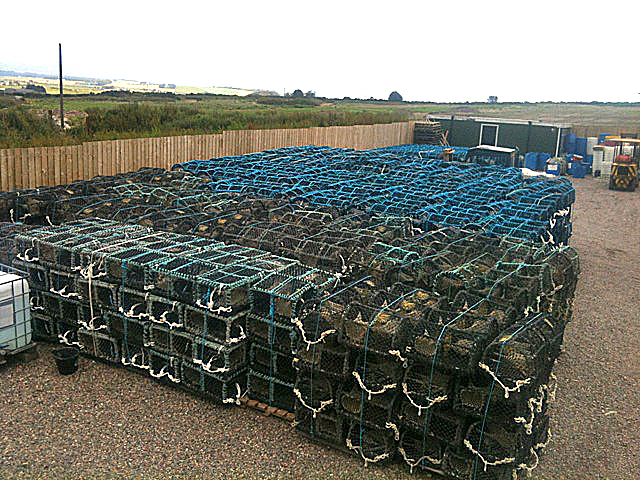
1,200 creels photographed in Ian Mathieson’s gear compound – with the addition of a further 200 parlours, this represents the total number of creels he has lost to mobile gear boats in 15 years.
Lost gear exceeds £140,000
Skipper Ian Mathieson stated that since 2000 he had lost around 1,400 creels and 32 miles of backing rope, with a replacement value in excess of £140,000.
So far this year, some £25,000 of his static gear has been towed away. This loss includes around 200 parlour creels, mainly in the past three months, towed away from the middle of the main box that Ian Mathieson has fished continuously since 2010.
Discussing the losses, onboard Dalwhinnie in Stonehaven harbour, Ian Mathieson said, “To many, these are just viewed as figures on a sheet of paper. In practical terms however, the harsh reality is that countless hours of work have gone into having to replace missing gear. Equally, trying to recover clumps of creels and ropes has posed considerable risk to my crew, as well as the boat.
“To give our losses some perspective, 1,400 parlours represent more than a month’s work for a leading creel manufacturer such as Caithness Creels, employing over 20 highly experienced full-time staff.
“Perhaps the most frightening aspect of this situation however, is that these losses are just from a single boat. When the total is widened to take account of the number of creel boats fishing from Wick to Burnmouth, the figure rises rapidly and becomes really scary. And this is just on the east coast of Scotland.
“That something needs to be done to reduce, if not eliminate, instances of gear conflict, is beyond dispute.
“Marine Scotland’s Task Force Report on gear conflict, which is scheduled to be published shortly, is keenly awaited by many, to see if the aim of delivering proportionate, enforceable and fair detection and deterrence will be addressed.”
Skipper Ian Mathieson reported losing a further 36 x 40in parlour creels, together with backropes, end weights and buoys with a value of around £4,500 on Wednesday of last week, after two leaders of gear were towed away and dumped.
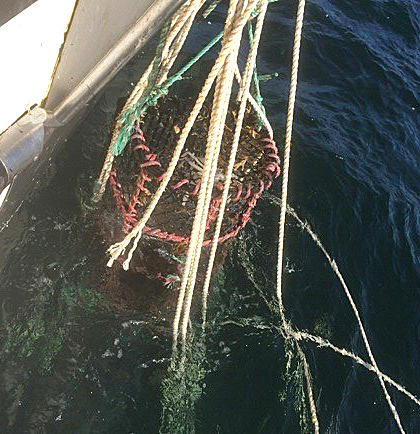
Trying to recover clumps of creels after they have been towed away can be difficult and time-consuming work.
Scottish Government: Gear conflict
Responding to a request by Fishing News for a comment on gear conflict issues, a Scottish Government spokeswoman said: “The Scottish Government understands that the majority of fishermen, whether static or mobile, co-operate well on a daily basis, sharing fishing areas when targeting the same species, without conflict. However when gear conflict occurs, it can have a significant effect on individual fishermen.
“This is the first time that gear conflict has been the subject of national public consultation. The Scottish Government is committed to introducing a new policy to tackle deliberate gear conflict and does not underestimate the challenges ahead.
“Marine Scotland sought views on gear conflict and options for a new policy direction. Ministers are considering the way forward, and the consultation outcome report will be published soon.”
Background
Gear conflict is a common law offence, better understood as vandalism or theft, and is primarily a matter for Police Scotland to investigate. Marine Scotland does not currently have a role in enforcing gear conflict, despite it often being the direct result of a regulated fishing activity. In response to growing frustrations from inshore fishermen, the Cabinet Secretary Richard Lochhead commissioned a Task Force on gear conflict that was critical of the current arrangements, in particular the lack of prosecutions, invariably due to the absence of definitive evidence. Marine Scotland consulted on a range of proposals and possible ways of making gear conflict a fisheries offence and improving the evidence gathering, while recognising the rights of individual fishermen regardless of the method they use to go to sea and earn a living. Proposals also included spatial separation, the introduction of technology and improvements to the marking of gear.
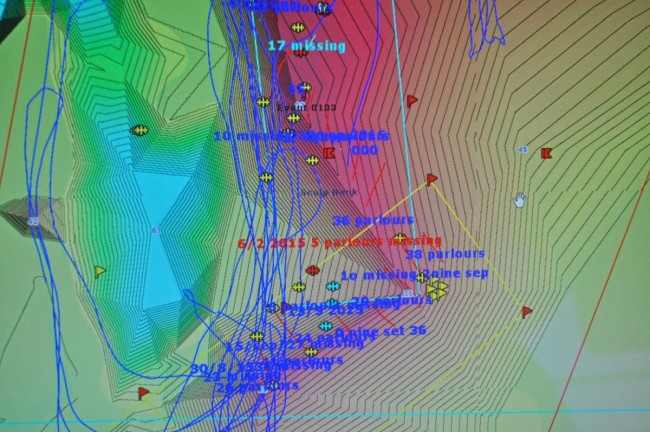
Tracks of mobile gear vessels towing in an area where static gear was lost on a number of occasions.
Fully-documented sustainable fishery
In 2011, in an attempt to reduce the number of creels being towed away, skipper Ian Mathieson started to fish in a box seven miles long and 2.1 miles wide, five miles east of Stonehaven. Initially, this area, which had previously been heavily fished, yielded disappointing catch levels.
“Gradually though, the number of brown crab and lobsters taken in a predominantly mixed fishery from fairly hard bottom, started to show potential. Releasing berried brown crab and lobsters, to enhance stock levels, slowly but surely started to bring increasing catches. Today, in fishing the box systematically, this area continues to give a sustainable fishery, as documented by detailed e-log figures showing the number of creels lifted and catch composition/quantity on a daily basis. By respecting this inner box, mobile gear skippers have played an important part in helping to turn this ground into one that is now supporting a sustainable crab and lobster fishery.
“This illustrates the degree to which static gear boats can develop increasingly healthy and productive grounds, to give a sustainable fishery, delivering top-quality catches, closely-geared to market requirements. With a focused effort, there is a clear potential to expand this way of working if conducted in a sensible manner. Rather than having strings of creels randomly shot, which creates difficulties for mobile gear skippers, they would benefit from knowing that all static gear in the area was being worked in clearly defined and well-known boxes, which would lead to a win/win situation rather than a lose/lose.
“At the same time though, it is devastating to see mobile gear boats landing large by-catches of often mutilated mature lobsters for which there is limited demand, or discarding them as they are too damaged to sell ashore.”
Read more from Fishing News, here.


Doing nothing is no longer an option, gear conflict issues need to be addressed with the upmost urgency.
After enduring 15 years of substantial static gear losses, Ian Mathieson, skipper/owner of the Stonehaven-based creel boat Dalwhinnie A 913, a Cleopatra Fisherman 42 built in 2011, has held meetings with Marine Scotland officials to highlight the severity of the problem and put forward proposals to resolve the longstanding and recurring issue, reports David Linkie.
Ian Mathieson has also brought his concerns and suggestions to the attention of Scottish Fisheries Minister Richard Lochhead, through his membership of the Scottish Creel Fishermen’s Federation and the recently formed Aberdeen Inshore Fishing Association, which has 10 member vessels fishing from Aberdeen, Stonehaven and Gourdon.
Ian Mathieson said: “In the past 15 years, I have continually tried to work with skippers of mobile gear vessels in order to avoid creels being towed away, by fishing in clearly defined boxes, the readings of which are constantly updated and readily available. While initially the readings were physically passed over to other skippers, today they are available electronically on the website of the SWFPA, of which I am a member. Non-member static gear boats also have direct access to this facility, which through skippers’ input, is constantly updated.
“Before continuing, I want to make it crystal clear that, like other creel boat skippers along the east and west coasts of Scotland, I have absolutely no problem with mobile gear boats fishing in close proximity to us, and fully recognise that they have their own set of problems to contend with. It is also important to point that that the vast majority of mobile gear skippers co-operate fully, and therefore are good to work with. However, as in all walks of life, a minority are not, and inevitably this results in substantial gear losses.
“Transfer of effort because of changing regulations in different fisheries has long been recognised as a major difficulty, although all too frequently it is an understated issue in fishing. Large beam scallopers, displaced from Area VII due to a shortage of days, regularly fish off the east coast of Scotland by necessity rather than choice. A similar situation occurred recently, when a combination of inadequate whitefish quotas and/or a shortage of fishing days, resulted in an influx of 20m+ squid trawlers fishing a few miles of Stonehaven.
“While fully sympathising with these lads for the difficult position they found themselves in due to rules and regulations applying to their fisheries, does this give them the leeway to sometimes blatantly tow through clearly marked static gear?
“Might is not always right. However, when management problems arise in one sector of the fleet, all too frequently they cascade down towards the smaller boats, with significant consequences.
“When the bigger nomadic scallopers started to fish off Stonehaven, I attempted to limit potential losses by working in clearly defined boxes on the top of peaky ground, which the scallopers couldn’t tow over. While this certainty wasn’t foolproof, it generally worked, and continues to help, thanks to those skippers who take the time to communicate in relation to static gear readings. The respect some mobile skippers show to their static gear counterparts clearly illustrates that, given the will, it is possible for everyone to fish in close proximity to each other, without any problems.
“One example of fishermen working together, and making the effort to help, was shown last month when a skipper phoned me to say that he recovered a lump of creels that went missing after being towed away out of a box. These creels were subsequently put ashore, enabling me to collect them and so avoid incurring a loss of around £1,000.
“When the squid trawlers started fishing in this area in August, each skipper was given the reading for a box seven miles long and 2.1 miles wide, five miles off the shore, that has given us a sustainable mixed crab and lobster fishery for the past four years.
“Initially, the squid boats found a steady fishing towing just inside the inner edge of this box. When catches started to tail off, they moved to the outer edge, where apparently catches were not so consistent. This led to boats starting to clip the corners of the inner box and, unsurprisingly, some creels were towed away. This situation quickly escalated, resulting in losses quickly moving north of £5,000.
“Apart from the financial cost of the creels, and the associated drop in catches, the most painful thing was the attitude of a minority of skippers, who complained that by fishing in our usual area, I was preventing them from earning good money. By constantly towing along ground on which healthy stocks of brown crab and lobster had been built up in recent years, through well-managed fishing, the benefits of sustainable fishing were effectively wiped out in a couple of weeks and will now take a long time to come back again.
“The final straw was observing a boat blatantly towing through clearly marked gear in the middle of the box on top of the ground, while yet again talking to Marine Scotland officials and advising them of the rapidly escalating carnage taking place.
“Gear conflict is by no means a new phenomenon, but it is one we have to put up with because Marine Scotland and the Scottish government are not dealing with it.
“This situation is intolerable, and cannot be allowed to continue.
“As Marine Scotland has no judicial powers, there was no other option left but to pass the information on to an authority that does. Although AIS tracks recorded on Dalwhinnie’s plotters identify boats towing through the middle of our leaders, where gear was subsequently found to be missing, proving this is a whole new ball game for the police, who are now investigating incidents of lost gear.
“I am fully aware of the fact that by speaking out about the problem, I will be extremely unpopular with some in our industry, but enough is enough; these blatant problems cannot be allowed to go on.
“Every static gear skipper accepts the fact that from time to time, a couple of creels will be lost off the end of a leader. But regularly losing 10/20/30 creels costing around £100 each, missing after a boat towed through an area where the location of static gear was advised to be located and clearly marked, is a totally different situation and mind-set.
“While losing gear is bad enough, large concentrations of creels and back ropes lying on the seabed for years to come does not exactly promote sustainable fishing, nor will it generate an image of a well-managed fishing industry in the eyes of the general public.”
Four proposals to reduce gear conflict
In his verbal and written communications with Scottish Fisheries Minister Richard Lochhead, and Jim Watson, Marine Scotland Head of Inshore Fisheries and Coastal Communities, skipper Ian Mathieson outlined four steps that could be taken to reduce ‘the long-standing problem of rogue vessels towing away and dumping static gear, that will continue until Marine Scotland take action to stop it’.
● Increase VMS pings from one every two hours to one every 10 minutes
Increasing the frequency of VMS pings to every 10 minutes would facilitate greater accuracy in plotting vessel movements, and help identify vessels responsible if static gear is towed away. The increase in VMS pings to be done on a trial period only, in coastal conflict areas rather than applying to the entire fleet.
● Encourage the MCA to enforce the legal requirement of >15m vessels to use AIS at all times
Compliance with this legal requirement would assist in tracking boats responsible for towing away static gear. Marine Scotland could assist the MCA with the enforcement through VMS. By sharing this information, Marine Scotland could inform the MCA when vessels are not displaying AIS. Marine Scotland could then decide what action to take with persistent offenders.
● Introduce a permit system that would ensure timely information sharing between fishermen
Implementing a permit system (at no cost nor dependent on previous track record) would guarantee the opportunity for Marine Scotland Fishery Officers to ensure that mobile gear skippers received the detailed positions of all static gear in an area, together with contact details for static gear skippers, when permits were issued in person at Fishery Offices.
● Make legal provision for the reparation of environmental damage caused by ghost fishing of towed creels
Fishermen who accept responsibility for towing away static gear and subsequently dumping it on the seabed to carry on ghost fishing, should meet the costs of recovering the gear.
Ian Mathieson said, “While I fully accept that these proposals will be seen as contentious by some, the current situation cannot be allowed to go on. At the same time though, such measures would not be required if a minority of skippers changed their attitude, as many of their colleagues have already done, and started to work with their static gear counterparts, rather than against them.
“Ultimately, internal disagreement between skippers, regardless of what size or type of vessel they operate, does not show the broader industry in a good light, which can only have negative consequences. Every skipper has commitments and is under constant pressure, but surely we should be trying to help each other reduce these, rather than escalate them.”

1,200 creels photographed in Ian Mathieson’s gear compound – with the addition of a further 200 parlours, this represents the total number of creels he has lost to mobile gear boats in 15 years.
Lost gear exceeds £140,000
Skipper Ian Mathieson stated that since 2000 he had lost around 1,400 creels and 32 miles of backing rope, with a replacement value in excess of £140,000.
So far this year, some £25,000 of his static gear has been towed away. This loss includes around 200 parlour creels, mainly in the past three months, towed away from the middle of the main box that Ian Mathieson has fished continuously since 2010.
Discussing the losses, onboard Dalwhinnie in Stonehaven harbour, Ian Mathieson said, “To many, these are just viewed as figures on a sheet of paper. In practical terms however, the harsh reality is that countless hours of work have gone into having to replace missing gear. Equally, trying to recover clumps of creels and ropes has posed considerable risk to my crew, as well as the boat.
“To give our losses some perspective, 1,400 parlours represent more than a month’s work for a leading creel manufacturer such as Caithness Creels, employing over 20 highly experienced full-time staff.
“Perhaps the most frightening aspect of this situation however, is that these losses are just from a single boat. When the total is widened to take account of the number of creel boats fishing from Wick to Burnmouth, the figure rises rapidly and becomes really scary. And this is just on the east coast of Scotland.
“That something needs to be done to reduce, if not eliminate, instances of gear conflict, is beyond dispute.
“Marine Scotland’s Task Force Report on gear conflict, which is scheduled to be published shortly, is keenly awaited by many, to see if the aim of delivering proportionate, enforceable and fair detection and deterrence will be addressed.”
Skipper Ian Mathieson reported losing a further 36 x 40in parlour creels, together with backropes, end weights and buoys with a value of around £4,500 on Wednesday of last week, after two leaders of gear were towed away and dumped.

Trying to recover clumps of creels after they have been towed away can be difficult and time-consuming work.
Scottish Government: Gear conflict
Responding to a request by Fishing News for a comment on gear conflict issues, a Scottish Government spokeswoman said: “The Scottish Government understands that the majority of fishermen, whether static or mobile, co-operate well on a daily basis, sharing fishing areas when targeting the same species, without conflict. However when gear conflict occurs, it can have a significant effect on individual fishermen.
“This is the first time that gear conflict has been the subject of national public consultation. The Scottish Government is committed to introducing a new policy to tackle deliberate gear conflict and does not underestimate the challenges ahead.
“Marine Scotland sought views on gear conflict and options for a new policy direction. Ministers are considering the way forward, and the consultation outcome report will be published soon.”
Background
Gear conflict is a common law offence, better understood as vandalism or theft, and is primarily a matter for Police Scotland to investigate. Marine Scotland does not currently have a role in enforcing gear conflict, despite it often being the direct result of a regulated fishing activity. In response to growing frustrations from inshore fishermen, the Cabinet Secretary Richard Lochhead commissioned a Task Force on gear conflict that was critical of the current arrangements, in particular the lack of prosecutions, invariably due to the absence of definitive evidence. Marine Scotland consulted on a range of proposals and possible ways of making gear conflict a fisheries offence and improving the evidence gathering, while recognising the rights of individual fishermen regardless of the method they use to go to sea and earn a living. Proposals also included spatial separation, the introduction of technology and improvements to the marking of gear.

Tracks of mobile gear vessels towing in an area where static gear was lost on a number of occasions.
Fully-documented sustainable fishery
In 2011, in an attempt to reduce the number of creels being towed away, skipper Ian Mathieson started to fish in a box seven miles long and 2.1 miles wide, five miles east of Stonehaven. Initially, this area, which had previously been heavily fished, yielded disappointing catch levels.
“Gradually though, the number of brown crab and lobsters taken in a predominantly mixed fishery from fairly hard bottom, started to show potential. Releasing berried brown crab and lobsters, to enhance stock levels, slowly but surely started to bring increasing catches. Today, in fishing the box systematically, this area continues to give a sustainable fishery, as documented by detailed e-log figures showing the number of creels lifted and catch composition/quantity on a daily basis. By respecting this inner box, mobile gear skippers have played an important part in helping to turn this ground into one that is now supporting a sustainable crab and lobster fishery.
“This illustrates the degree to which static gear boats can develop increasingly healthy and productive grounds, to give a sustainable fishery, delivering top-quality catches, closely-geared to market requirements. With a focused effort, there is a clear potential to expand this way of working if conducted in a sensible manner. Rather than having strings of creels randomly shot, which creates difficulties for mobile gear skippers, they would benefit from knowing that all static gear in the area was being worked in clearly defined and well-known boxes, which would lead to a win/win situation rather than a lose/lose.
“At the same time though, it is devastating to see mobile gear boats landing large by-catches of often mutilated mature lobsters for which there is limited demand, or discarding them as they are too damaged to sell ashore.”
Read more from Fishing News, here.

